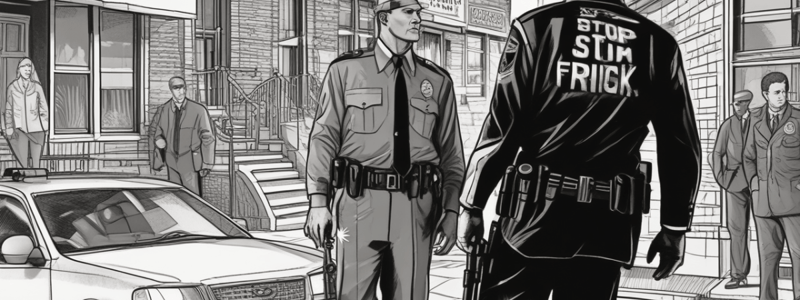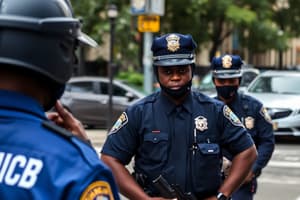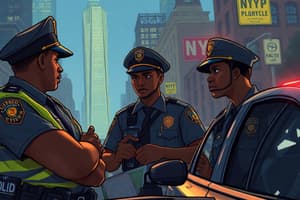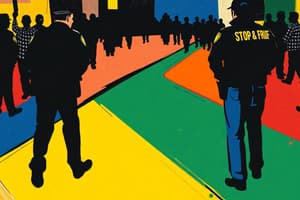Podcast
Questions and Answers
Under what circumstances can a law enforcement officer temporarily detain a person according to the Florida Stop and Frisk Law?
Under what circumstances can a law enforcement officer temporarily detain a person according to the Florida Stop and Frisk Law?
- When circumstances reasonably indicate that the person has committed, is committing, or is about to commit a violation of the criminal laws (correct)
- When the officer has probable cause to believe the person has committed a crime
- When the officer has a warrant for the person's arrest
- When the person is loitering in a high-crime area
How long can a person be temporarily detained under the Florida Stop and Frisk Law?
How long can a person be temporarily detained under the Florida Stop and Frisk Law?
- Until the person is charged with a crime
- No longer than is reasonably necessary to effect the purposes of the act (correct)
- Until the officer has probable cause to arrest the person
- Until the officer completes a thorough search of the person
What is required for a police officer to conduct a stop and frisk under F.S.§901.151?
What is required for a police officer to conduct a stop and frisk under F.S.§901.151?
- A reasonable articulated suspicion (correct)
- Probable cause to believe the person has committed a crime
- Permission from the person's lawyer
- A warrant for the person's arrest
Can a police officer use drawn weapons in a Terry stop?
Can a police officer use drawn weapons in a Terry stop?
What is the purpose of temporarily detaining a person under F.S.§901.151?
What is the purpose of temporarily detaining a person under F.S.§901.151?
What is required for an officer to temporarily detain a person under F.S.§901.151?
What is required for an officer to temporarily detain a person under F.S.§901.151?
What determines whether an officer has a reasonable suspicion to conduct a stop and frisk?
What determines whether an officer has a reasonable suspicion to conduct a stop and frisk?
Can an officer temporarily detain a person under F.S.§901.151 for a reported misdemeanor performed outside of their presence?
Can an officer temporarily detain a person under F.S.§901.151 for a reported misdemeanor performed outside of their presence?
What is the basis for a temporary investigative detention?
What is the basis for a temporary investigative detention?
What is the maximum time limit for a temporary investigative detention?
What is the maximum time limit for a temporary investigative detention?
What is the penalty for giving a false name or identity to a law enforcement officer?
What is the penalty for giving a false name or identity to a law enforcement officer?
What is the basis for a pat-down search for weapons?
What is the basis for a pat-down search for weapons?
What is the primary purpose of a frisk?
What is the primary purpose of a frisk?
When can an officer conduct a frisk without reasonable suspicion?
When can an officer conduct a frisk without reasonable suspicion?
What is the ruling in the case of Minnesota v. Dickerson?
What is the ruling in the case of Minnesota v. Dickerson?
What is required for an officer to conduct a pat-down of a driver or passenger during a traffic stop?
What is required for an officer to conduct a pat-down of a driver or passenger during a traffic stop?
What is the significance of furtive movements in a stop and frisk?
What is the significance of furtive movements in a stop and frisk?
What is the ruling in the case of Reynolds v. State?
What is the ruling in the case of Reynolds v. State?
When can an officer conduct a search incident to arrest?
When can an officer conduct a search incident to arrest?
What is the significance of the case of Turner v. State?
What is the significance of the case of Turner v. State?
What is not a sufficient reason for an officer to conduct a frisk?
What is not a sufficient reason for an officer to conduct a frisk?
What is the basis for a lawful stop?
What is the basis for a lawful stop?
What is the exception to the rule that an officer must have an independent suspicion that the suspect is armed?
What is the exception to the rule that an officer must have an independent suspicion that the suspect is armed?
What is not sufficient to justify a frisk?
What is not sufficient to justify a frisk?
What is the significance of the case of Dewberry v. State?
What is the significance of the case of Dewberry v. State?
What is the requirement for an investigatory stop?
What is the requirement for an investigatory stop?
What can an officer do during a frisk?
What can an officer do during a frisk?
When can an officer order a suspect to spit out the contents of their mouth?
When can an officer order a suspect to spit out the contents of their mouth?
What is the minimum requirement for an officer to legally conduct an investigatory stop?
What is the minimum requirement for an officer to legally conduct an investigatory stop?
What is the purpose of a pat-down search?
What is the purpose of a pat-down search?
What is the result of an officer initiating questioning in a public place?
What is the result of an officer initiating questioning in a public place?
What is required for a consent to search to be valid?
What is required for a consent to search to be valid?
What constitutes a seizure under the Fourth Amendment?
What constitutes a seizure under the Fourth Amendment?
What is the rule regarding a school official asking a school resource officer to pat down a student for weapons?
What is the rule regarding a school official asking a school resource officer to pat down a student for weapons?
What is the consequence of refusing to provide identification when stopped by a police officer?
What is the consequence of refusing to provide identification when stopped by a police officer?
When can a police officer conduct a search of a person's belongings?
When can a police officer conduct a search of a person's belongings?
What is the purpose of a police officer initiating questioning in a public place?
What is the purpose of a police officer initiating questioning in a public place?
What is the standard for a police officer to legally detain a person?
What is the standard for a police officer to legally detain a person?
What is the primary goal of the alternative methods used in the Eyewitness Identification Reform Act?
What is the primary goal of the alternative methods used in the Eyewitness Identification Reform Act?
What instruction is not required to be given to the eyewitness before a lineup if a specified and approved alternative method of neutral administration is used?
What instruction is not required to be given to the eyewitness before a lineup if a specified and approved alternative method of neutral administration is used?
Under what circumstances can an officer conduct a frisk if they cannot identify a weapon and the bulge is in the waist area?
Under what circumstances can an officer conduct a frisk if they cannot identify a weapon and the bulge is in the waist area?
What is the consequence of noncompliance with the requirements of the Eyewitness Identification Reform Act?
What is the consequence of noncompliance with the requirements of the Eyewitness Identification Reform Act?
What is the purpose of the instruction that the eyewitness should not feel compelled to make an identification?
What is the purpose of the instruction that the eyewitness should not feel compelled to make an identification?
What was the holding in the 1993 U.S. Supreme Court decision in Minnesota v. Dickerson?
What was the holding in the 1993 U.S. Supreme Court decision in Minnesota v. Dickerson?
What is the significance of the instruction that the perpetrator might or might not be in the lineup?
What is the significance of the instruction that the perpetrator might or might not be in the lineup?
What is required to search a vehicle?
What is required to search a vehicle?
What is an example of an alternative method of neutral administration?
What is an example of an alternative method of neutral administration?
What can an experienced officer conclude based on plain feel during a lawful pat-down?
What can an experienced officer conclude based on plain feel during a lawful pat-down?
What is the consequence of a failure to comply with the requirements of the Eyewitness Identification Reform Act at trial?
What is the consequence of a failure to comply with the requirements of the Eyewitness Identification Reform Act at trial?
What is the result of simply seeing a partially concealed firearm?
What is the result of simply seeing a partially concealed firearm?
What is required to frisk a suspect who is present at the scene of a crime?
What is required to frisk a suspect who is present at the scene of a crime?
What is the purpose of the Eyewitness Identification Reform Act?
What is the purpose of the Eyewitness Identification Reform Act?
What is required of the eyewitness before a lineup?
What is required of the eyewitness before a lineup?
What was the holding in the case of In re J.B.?
What was the holding in the case of In re J.B.?
What is an example of a remedy available as a consequence of noncompliance with the requirements of the Eyewitness Identification Reform Act?
What is an example of a remedy available as a consequence of noncompliance with the requirements of the Eyewitness Identification Reform Act?
Under what circumstances can an officer conduct a frisk if they observe the outline of a gun through a bulge?
Under what circumstances can an officer conduct a frisk if they observe the outline of a gun through a bulge?
What is the primary purpose of the Fifth Amendment protection in a criminal case?
What is the primary purpose of the Fifth Amendment protection in a criminal case?
What was the holding in the case of Conyers v. State?
What was the holding in the case of Conyers v. State?
What can an officer do if they have a reasonable suspicion that a defendant is armed and dangerous?
What can an officer do if they have a reasonable suspicion that a defendant is armed and dangerous?
What type of evidence is not protected by the Fifth Amendment?
What type of evidence is not protected by the Fifth Amendment?
What is the standard for the admissibility of testimony concerning an out-of-court identification?
What is the standard for the admissibility of testimony concerning an out-of-court identification?
What is the primary concern when evaluating the reliability of an eyewitness identification?
What is the primary concern when evaluating the reliability of an eyewitness identification?
Under what circumstances may an 'in-court' identification of a defendant be admissible?
Under what circumstances may an 'in-court' identification of a defendant be admissible?
What is the primary purpose of evaluating the 'suggestiveness' of an eyewitness identification procedure?
What is the primary purpose of evaluating the 'suggestiveness' of an eyewitness identification procedure?
What is the significance of the 'totality of the circumstances' in evaluating an eyewitness identification?
What is the significance of the 'totality of the circumstances' in evaluating an eyewitness identification?
What is the result of an eyewitness identification procedure that is 'so impermissibly suggestive as to give rise to a very substantial likelihood of irreparable misidentification'?
What is the result of an eyewitness identification procedure that is 'so impermissibly suggestive as to give rise to a very substantial likelihood of irreparable misidentification'?
What is an example of a physical evidence that a suspect may be compelled to provide?
What is an example of a physical evidence that a suspect may be compelled to provide?
What is the primary concern when evaluating the reliability of an eyewitness identification made at a pre-trial hearing?
What is the primary concern when evaluating the reliability of an eyewitness identification made at a pre-trial hearing?
Flashcards are hidden until you start studying
Study Notes
Florida Stop and Frisk Law
- Under F.S.§901.151, law enforcement officers can temporarily detain a person if they reasonably believe the person has committed, is committing, or is about to commit a crime.
- The detention is limited to the time necessary to investigate and must be in the immediate vicinity where the detention was made.
Frisking
- A frisk can be conducted to feel for weapons, and it's essentially a "pat-down" of the suspect.
- The officer can pat-down a citizen's bag or container if they have the right to frisk the individual.
- A frisk is not a full-blown search, but a self-protective procedure to feel for weapons.
- An officer must have a reasonable suspicion to conduct a frisk, and it's not a routine procedure.
Violent Crimes
- An officer can base a reasonable suspicion to stop and frisk on various factors, including observing a dangerous or suspicious movement, or confirming an anonymous tip.
- If an officer suspects a violent crime, they can frisk the suspect.
Bulge Seen on Suspect
- If an officer sees a bulge on a suspect, they can frisk the suspect, but only if they can identify a weapon or if there's some other indication of criminal activity.
- If the officer can't identify a weapon, a frisk is only authorized if the officer is responding to a report of a crime involving a weapon.
Presence at Scene of a Crime
- An officer cannot frisk a suspect merely because they are present at the scene of a crime.
- There must be some other factual basis to reasonably believe the suspect is involved in the crime.
Fruits of a Weapons Search
- If an officer finds contraband during a frisk, it's admissible evidence if the officer had reasonable suspicion to conduct the frisk.
- The contraband must be instantly recognizable by "plain feel."
Use of Handcuffs
- Handcuffing a person during a stop and frisk is reasonable when circumstances justify the use of restraint.
- The continued use of handcuffs after the pat-down is illegal.
Investigatory Stops
- There must be a well-founded suspicion that criminal activity is afoot for an investigatory stop.
- A "hunch" alone is not enough for an investigatory search.
- Officers must articulate reasons for their suspicions.
Pat-Down for Weapons
- A police officer can conduct a weapons search if there is probable cause to believe the person is armed.
Questioning
- Police may initiate questioning in a public place, and citizens may voluntarily cooperate.
- If the contact between the police officer and citizen evokes voluntary cooperation, the encounter is not a seizure.
Illegal Search and Seizure
- A consent to search given after illegal police conduct is presumptively tainted and deemed involuntary.
- However, if there is a clear break in the chain of official illegal action, the consent may be valid.
Identification Requirement
-
When a person is stopped based on reasonable suspicion, they must identify themselves.
-
If they refuse, they can be arrested.
-
A suspect may be compelled to furnish a blood sample, handwriting exemplar, or voice exemplar.### Admissibility of Eyewitness Identification
-
The admissibility of eyewitness identification depends on its reliability and suggestiveness, which is determined by the totality of the circumstances.
-
Factors examined to determine reliability and suggestiveness include:
- The opportunity of the witness to view the suspect at the time of the crime (length of time, lighting, face-to-face or side view, etc.)
- The witness' degree of attention
- The accuracy of the witness' prior description of the criminal
- The level of certainty demonstrated by the witness at the confrontation
- The length of time between the crime and the confrontation
Cases
- In Davis v. State (2000), the court upheld a show-up identification conducted two hours after the crime.
- In Tumblin v. State (1999), the in-court identification was still reliable despite the victim failing to pick the defendant out of a pre-trial photo lineup.
Eyewitness Identification Reform Act
- The Act, F.S. § 92.70, passed in 2017, creates new requirements for lineups conducted in Florida.
- Requirements include:
- The lineup must be conducted by an independent administrator.
- In lieu of an independent administrator, a law enforcement agency may conduct a photo lineup using an alternative method that achieves neutral administration.
- Alternative methods include:
- Automated computer programs
- Procedures using folders with randomly numbered and shuffled photographs
- Any other procedure that achieves neutral administration and prevents the lineup administrator from knowing which photograph is being presented.
Pre-Lineup Instructions
- Before a lineup, the eyewitness must be instructed that:
- The perpetrator might or might not be in the lineup
- The lineup administrator does not know the suspect's identity
- The eyewitness should not feel compelled to make an identification
- It is as important to exclude innocent persons as it is to identify the perpetrator
- The investigation will continue with or without an identification
Consequences of Noncompliance
- A failure to comply with any requirement of the Eyewitness Identification Reform Act may be considered by the court when adjudicating motions to suppress eyewitness identification.
- A failure to comply with any requirement of the Act is admissible in support of a claim of eyewitness misidentification.
- If evidence of compliance or noncompliance is presented at trial, the jury shall be instructed to consider credible evidence of compliance or noncompliance to determine the reliability of eyewitness identifications.
Studying That Suits You
Use AI to generate personalized quizzes and flashcards to suit your learning preferences.




